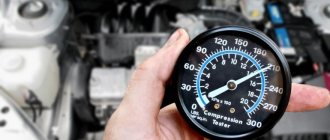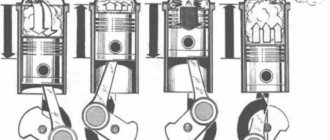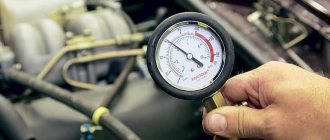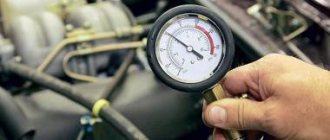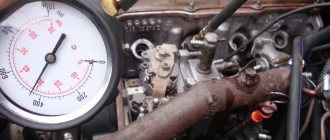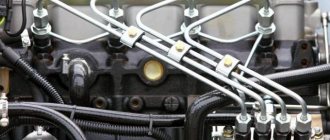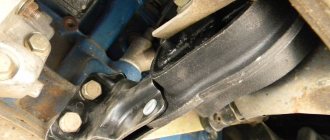Engine compression
Engine compression indicates the condition of the engine, its service life, power, and torque. This procedure must be performed every 20-30 thousand kilometers, as well as before purchasing a car. Even when checking at a service center, YOU will need knowledge of “how to correctly measure compression”, because... Servicemen love to deceive and make money from you. Let's start with the theory: Compression is the pressure created in the cylinder at the end of the compression stroke. Another term is appropriate here: Engine compression ratio. The engine compression ratio is expressed in the following ratio: compression/combustion chamber volume.
What compression should be in the cylinders of a VAZ engine?
Normal engine compression is at least 10 bar (1.0 MPa), and the difference between the cylinders should not exceed 1 bar (0.1 MPa). If your compression is 11-12-11-12 from cylinders 1 to 4, then the engine is fine, but do not forget to adjust the valves every 2500 km. If you have 11-9-12-11, then you need to look for the reason and make repairs, because Driving in such conditions will only kill the engine.
How much should the ideal compression be? The ideal compression should be 14 bar for an 8-valve engine in each cylinder with minimal variation (14-14-14-14).
WHAT TO DO IF YOU DO NOT HAVE A COMPRESSOMETER AT HAND?
Is it possible to measure compression without a device? Practice shows that yes, it is possible. But this method will give relative and approximate readings. To measure the compression indicator without instruments, remove the spark plugs from all cylinders except the one being tested. Manually rotate the crankshaft until the compression stroke ends (watch the marks - they should match). Perform this operation on all cylinders one by one. Where the pressure is low, it will take less effort to turn the crankshaft. In this way, of course, you will not get accurate compression readings in the engine. But it is possible to understand the presence of problems.
It is recommended to measure compression every 20-30 thousand kilometers, so every car enthusiast is recommended to have his own compression gauge. Its price is not so high that it is worth saving on it.
The approximate price of a device for measuring engine compression in online stores in the capital is from 600 rubles to 2 thousand. Branded models from Western manufacturers are more expensive – up to 8 thousand. In the regions, a device for measuring compression costs no more than in the capital. Its price varies depending on the manufacturer.
The optimal compression in engine cylinders is different for diesel and gasoline engines. compression in the engine cylinders guarantees stable operation of the unit. It must be measured when the piston is at the top point. Whether the engine will run depends on whether the pressure in the cylinders is correct. In the absence of compression, various problems are possible, premature wear due to uneven pressure in different chambers. The level of this indicator affects the following factors:
- Does the fuel burn completely?
- Engine oil consumption.
- Correct operation of the cylinders and piston group.
- With low compression, friction between engine parts increases significantly.
- The higher the indicator, the easier it is to start the engine.
- Low pressure leads to loss of power, the car practically does not move.
Many people are faced with the fact that their car has no compression in the engine; our article will tell you what to do in this case.
How to measure engine compression?
To check the compression we need a spark plug wrench, a charged battery and a compression gauge. You also can’t do without an assistant.
- Warm up the engine to operating temperature.
- We turn out all the candles.
- We install a device for measuring compression (compressometer) into the spark plug hole that appears.
- The assistant presses the gas all the way and starts the car within 6-10 seconds.
- We remember the compression gauge readings and carry out similar operations on the remaining cylinders.
How to measure compression without a compression gauge?
Engine compression is measured using a special device - a compression meter. He gives accurate readings. If you don't have a compression gauge at hand, there is also a way to take measurements. True, their result may not be so accurate. This is done like this:
- Unscrew the spark plugs from all cylinders except one;
- Turn the crankshaft by hand;
- Repeat the procedure with all cylinders.
If in any case the crankshaft rotates more easily, then the compression in that cylinder is reduced. You can check this by injecting some oil into it with a syringe. If after this the rotation is very difficult, the part is worn out.
Low and different compression in the engine, what to do?
If, after checking the compression, the compression meter shows below 10 bar in at least one cylinder, then you urgently need to find out the cause and fix the problem, otherwise you risk losing compression in the remaining cylinders.
If, for example, you do not have sufficient compression in 1.4 and any other cylinder:
- We fill a medical syringe with about 10 cubic centimeters of motor oil.
- Spray oil into the hole that appears.
- We measure the compression again.
If, after re-measuring, the compression has increased, it means the rings are worn out. If the result remains the same, it means the valves are burnt out or jammed. Stiff valves can be adjusted, and burnt valves can be replaced.
Reasons for low compression
Most often, motorists ask the question of what compression should be in the VAZ 2114 when it is lowered. This phenomenon is more common than increased compression. And the main reasons for low compression are:
- Worn oil scraper rings. Over time, these motor elements wear out and need to be replaced.
- Burnt out valves. This usually happens when the engine overheats due to improper operation and untimely maintenance.
- Wear of the piston group. This can be determined when disassembling the power unit. It occurs from time to time or when the rules of operation and maintenance are violated.
- Incorrect valve adjustment. This causes the valve to fail to close, resulting in reduced compression.
- Clogged air filter. The motor does not receive enough air, which can also cause problems.
- Severe wear or breakage of the timing belt, or incorrect installation. If the belt slips, the valves of the VAZ 2114 do not bend. But this problem also leads to decreased compression.
- Cylinder head gasket failure. Gases enter the oil line or cooling system.
- Cracks in the cylinder head. This defect can be seen during visual inspection.
As mentioned above, how much compression should be, it should be the same in all cylinders. Even if in one of them it is significantly lower than required, this indicates a malfunction of the power unit and the need for its repair.
High compression in the engine. Main reasons.
Don't be too happy if your compression readings are off the charts, this is in no way indicative of how cool your engine is. As stated above, the ideal compression for an 8-valve engine is 14-14-14-14. If your compression is higher than these numbers, then it’s time to think about malfunctions. High compression can damage the partitions of the pistons and tear the cylinders. Below are the main reasons for high/high compression: High compression is created due to excess oil in the cylinder, which is why it is sometimes also called “oil compression”.
- The valve stem seals (VSC) have worn out and died.
- The oil scraper rings are worn out or stuck. (In such cases, oil consumption is inevitable. Check the oil level: How to check the oil level in the engine? Also pay attention to starting the engine after a long stop, for example, in the morning. If the engine oil is consumed, the exhaust will be black).
- There may be carbon deposits in the cylinders. Try to get rid of it by decoking.
Factors influencing compression of internal combustion engines
Compression in an engine is the pressure generated in the cylinder as the piston moves from BDC to TDC.
Normal compression in a VAZ 2114 engine
Compression is affected by many different factors.
- The pressure inside the volume is determined by the amount of gas entering. In an internal combustion engine, this is influenced by the throttle valve and the air filter capacity. Therefore, it is so important to promptly change a clogged filter element.
- During adjustment or repair work, car mechanics may make inaccuracies in setting the valve timing. As a result, the closing timing of the intake valve changes. The cycle is disrupted and this leads to a change in pressure in the cylinders.
- Incorrect adjustment of the clearances in the valve drive also leads to deviations in compression from the maximum effective one.
- Engine power, which directly depends on the degree of compression in the cylinders, is affected by the temperature of the internal combustion engine. If for some reason it is significantly lower than the established working value, then the compression in the cylinders will be less and, accordingly, the power will decrease.
- Due to burnout of valves and cylinder walls, worn-out rings, and some other mechanical damage to the piston group, mixture leaks from the cylinder during the compression stroke. As a result, compression is reduced.
- For some reason, excess fuel enters the cylinder, gasoline settles on the inner walls and washes away oil from them, reducing the seal, and leading to additional air leaks, as well as a decrease in the power of the power unit.
In its turn:
- the correct oil layer on the cylinder walls leads to sealing of gaps and reduction of leaks;
- an increase in engine temperature heats up the parts, the metal of which expands and they fit closer together, preventing the formation of unnecessary gaps, as a result the engine power increases;
- the higher the crankshaft speed, the sharper the piston movement and the more efficient the compression occurs, this also increases the pressure in the cylinder and, accordingly, the engine power.
Signs of poor compression
If you encounter the problems outlined below, then it is possible, BUT FAR FAR from a fact, that your engine has insufficient compression. Therefore, you don’t need to pay attention to the signs, but you just need to measure the compression.
- Misfires.
- Troit.
- Low dynamics.
- Engine knock.
- There is oil.
- Black smoke.
- Poor cold start.
- High fuel consumption (Causes of high fuel consumption on VAZ).
Causes of increased compression
When thinking about what the compression in an engine should be, it is important to understand that it should not be too high. And the reasons for this may be:
- Worn or stuck oil seals. You can see this problem without removing the cylinder head. When unscrewing the spark plugs, an oil film is visible in the spark plug wells. And it can be solved by replacing parts or decarbonizing them with chemicals.
- There is carbon deposits on the valves, carbon deposits in the throttle body and on the cylinder walls. It can be noticed when examining these parts.
- Errors in adjusting the gas distribution mechanism.
- Engine overheating.
How to increase engine compression in other ways?
There are several options for raising compression without repair. These operations do not in any way guarantee an increase in compression, but you can try. But it is still recommended to eliminate the malfunction by mechanical action - eliminate the malfunction: replace the rings or replace the valves.
- Adjustment of valves. I tried it myself, it really works. The valve could be jammed and therefore not close, resulting in a compression leak.
- Roscoking – removes carbon deposits and excess oil in the cylinder. It only helps with stuck rings; if the valves are burnt out, there is no point in carrying out this operation.
We carry out checks for an 8 valve car
So, the procedure for checking the motor yourself is not particularly difficult. Having the necessary skills and a device with which you can measure pressure, the procedure can be carried out independently. Naturally, for this you will have to follow certain requirements, which are listed below. If you know what the compression should be in the internal combustion engine, then you can start working.
Loading …
Step by step instructions
The first thing you will need to measure the pressure level in the engine is a device with which you will do this. How can we measure this coefficient? The device for this is called a “compressometer”. Such a device can be of several types:
- universal device;
- threaded;
- flexible;
- clamping
This is what a pressure measuring device looks like disassembled.
You will need to find such a device. Also, in this matter you will need the help of a friend, since you will have to simultaneously perform some actions both inside the cabin and in the engine compartment. In addition to the compression gauge, prepare a wrench for removing the spark plugs. Please note that it is better not to perform any work if the battery is not working. Therefore, fully charge your battery. So, let's start checking:
- First, get behind the wheel and start the engine. Let it idle and warm up to 90 degrees, that is, to operating temperature.
- After this, open the hood and take the key to remove the spark plugs. You need to remove the high-voltage wires, and then dismantle all the spark plugs. The wires fit to the spark plugs, you just need to pull them out.
- Now remove the ECU fuse to avoid possible damage to the device.
- When the spark plug is dismantled, you need to install your device in its hole to check the pressure level. Do this carefully so as not to damage the threads.
- Now you will need a friend's help. Ask him to sit in the driver's seat. The assistant must press the gas pedal all the way so that the throttle valve can open completely.
- Then turn on the starter and turn the crank pulley with it. This is done until the readings on the compression gauge stop increasing. As a rule, this takes no more than 10 seconds. In this case, the crank pulley must rotate, and its rotation speed should not exceed 100 rpm.
- Now you can read the received readings. Better write them down. Remember what the compression should be and compare these readings with the received ones. Once the readings are recorded, the device's needle can be set to zero.
- This procedure should be repeated for each cylinder of the VAZ 2114 8 valve engine.
First open the hood and remove all spark plugs
Measure the pressure readings and check the standards.
As you understand, there is nothing particularly difficult in this procedure. You just need to carry out all the measuring steps correctly and you will get the most accurate results.
PREPARATION FOR MEASUREMENTS
Engine compression is measured with a fully charged battery. After charging and installing the power source in place, check the starter. It shouldn't create any problems either. Then warm up the engine. Its temperature during measurements should be 70-90 O C.
It is necessary to unscrew all spark plugs from all holes. Also unscrew the fuel hose to stop the fuel supply. Prepare the compression gauge for use.
Compressometer
Abnormal indicators
As you probably could have guessed, this is when in one of the four cylinders the pressure is significantly different from the others, for example in one it is 5.0, and in the others it is 9.5 atm. YES and the engine will not work stably. There are abnormal indicators in two and even three or four “pots”. But this already means that your engine is almost dead and needs to be overhauled!
So why does this happen - when in one the pressure is much less than in the others? There may be several reasons for this, all from my experience, but you almost always need to remove the cylinder head:
1) The gasket is broken . This happens very often when the gasket between the block and the block head breaks - we just replace it.
2) The head is not tightened . This is a continuation of the first reason - if the head is not tightened correctly, the gasket can also leak pressure.
These are the simplest reasons, but they are the most common - for example, this often happened on my new purchased VAZs, in particular on a VAZ 2114 and a friend on a VAZ 2110. So, first of all, we go there, on new "our brands" - the problem This will be 80%. Then there are more complicated problems.
1) O-rings leak . This happens due to wear and tear, or because they are broken. However, if the pressure has dropped in one of the cylinders, then it is most likely broken. The repair is complicated, you need to disassemble the block itself to remove the pistons.
2) The rings are coked . I decided to put it in a separate section - low-quality motor oil can cause the rings to become coked.
The oil simply burns at the points of contact and seals the rings in one place - although this is not correct, the rings do not move along their grooves, and only one side is machined, which leads to rapid wear - although in this way the pressure will drop in all 4 cylinders. Because oil lubricates all 4 pieces.
3) Wear of the block wall . This is rare - but it does happen, that is, the ring has nothing to do with it, but it is the walls that they rub against that suffer. Most likely, this is low-quality material.
4) Engine overheating . When overheated, the tightness of the rings and walls of the block is lost, they begin to leak both pressure and engine oil. An indirect sign is blue smoke from the exhaust pipe during operation.
5) Burnt out - the piston itself broke . In such cases, compression may simply drop to “zero”.
Sometimes the piston itself burns out, it can be a small “burnout” on the side, or a very large one – for example, in the middle. It also happens that the piston breaks, for example from meeting a valve when the timing belt breaks - again we lose atmosphere.
6) Valves . There are many reasons for this. This is also an incorrect adjustment. And it happens that a valve burns out - only one burns, so the compression will vary in exactly one cylinder. It can also break if the timing belt breaks.
These are the main reasons why the values will differ in exactly one pot out of all four.
Pressure measurements
We have already answered what the normal compression for a VAZ 2114 should be. Now let's look at how to actually measure it? First we need a special device called a compression meter.
Compressometer
All measurements using it are performed in the following order:
- Fully charge the battery.
- Warm up the engine to 75-90 degrees. WITH.
- After the engine warms up, remove all spark plugs.
- Disconnect the fuel supply hose.
- Insert the measuring device into the first spark plug hole.
- Press the gas pedal and hold it (to do this, two people need to take measurements).
- Start the starter and turn the crankshaft with it.
- Wait until the readings on the dial (monitor) of the device reach the maximum - this will be the compression value in a particular cylinder.
- Move the compression gauge to another spark plug hole and continue measurements.
After the pressure is measured in all cylinders, conclusions can be drawn about the general condition of the engine and the need for its repair/restoration.
If the compression is not normal, then you should stop driving the car and try to solve this problem first. Otherwise (especially if the pressure is very high), the engine may completely fail, after which it will need to be completely restored.
conclusions
It was found that normal compression for a VAZ-2114 engine is 11-14 bar . An increase or decrease in this indicator, as well as a gap of more than 1 bar between the cylinders, is not considered normal and is subject to diagnosis. Engine compression is measured using a compression gauge.
There are several inaccuracies. Firstly, compression is traditionally measured with the engine not running at the starting speed generated by the starter! This is important: the pressure at the end of the compression stroke depends on the crankshaft speed, so if the engine is running, the compression will be much higher than the specified range - up to several times! Secondly, compression is measured on a warm engine (although there are some “former” ones who measure it on a cold engine, but the result is no more than a “funny letter”!). Third, the throttle must be fully open. Otherwise, the required amount of air will not be supplied, so the readings will be underestimated (there is nothing to compress!). On an injection engine, when the throttle valve is fully opened, the fuel supply and sparking stop (so-called cylinder purging). So there is no need to additionally turn off the ignition system (unlike carburetor engines). Fourthly, not only the absolute value of the pressure itself is important, but also how quickly it builds up. This indicator characterizes the condition no less accurately than the pressure itself. Ideally, a fixed value should be achieved in 2-3 “pumps”. And fifthly, the compression level is also affected by the condition of the starter and the flywheel ring gear: if the teeth are worn out and jammed, the compression value will also be underestimated. In general, for a more accurate assessment of the condition, the leak method is now much more often used.
Signs of low compression and how to measure it on a VAZ engine
Compression on a VAZ 2114 should be measured every 30 thousand kilometers. This is usually done in conjunction with adjusting the valves. However, signs of low compression may not only appear with a routine check. As you use your car, signs of poor compression are easy to spot; you just need to keep a close eye on your engine. These are phenomena such as:
- ICE strength drops sharply;
- the engine fires, this can happen when low compression occurs in one cylinder;
- significantly increases oil and gasoline consumption.
Ways to increase compression
A decrease in compression does not always mean the need for a major engine overhaul. After all, it can arise for other reasons. Many of them can be eliminated with your own hands. To do this you need:
- Replace the air filter and spark plugs if they are in poor condition and have been changed for a long time.
- Adjust the valves;
- Replace oil rings. You can do this yourself by first assessing the condition of the old elements;
- Replace or correctly install the timing belt. This procedure is described in the article Timing timing marks on the VAZ 2114. Decarbonize the engine. Chemicals are used for this. They can be bought at any auto store. The composition is poured into the engine in accordance with the instructions. The chemical must remove carbon deposits and other contaminants on the engine walls. This will help him restore stable work.
